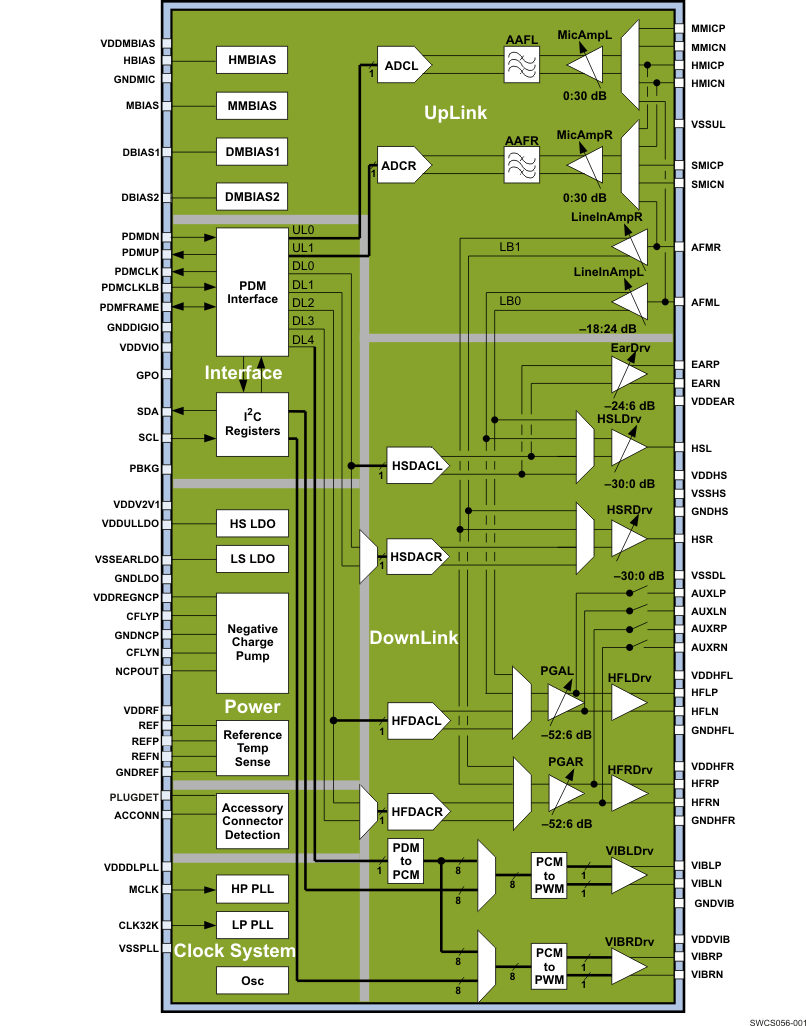SWCS058D August 2010 – August 2014 TWL6041
PRODUCTION DATA.
Package Options
Mechanical Data (Package|Pins)
- YFF|81
Thermal pad, mechanical data (Package|Pins)
Orderable Information
1 Device Overview
1.1 Features
- Four Audio Digital-to-Analog Converter (DAC) Channels
- Stereo Capless Headphone Drivers
- Up to 104-dB DR
- Power Tune for Performance and Power Consumption Tradeoff
- Stereo 8 Ω, 1.5 W per Channel Speaker Drivers also with 4-Ω Support Capability
- Differential Earpiece Driver
- Stereo Line-Out
- Two Audio Analog-to-Digital Converter (ADC) Channels
- 96-dBA SNR
- Four Audio Inputs:
- Three Differential Microphone Inputs
- Stereo Line-In and FM Input
- Two Vibrator and Haptics Feedback Channels
- Differential H-bridge Drivers
- Two Low-Noise Analog Microphone Bias Outputs
- Two Digital Microphone Bias Outputs
- Analog Low-Power Loop from Line-in to Headphone and Speaker Outputs
- Dual Phase-Locked Loops (PLLs) for Flexible Clock Support:
- 32-kHz Sleep Clock Input for System Low-Power Playback Mode
- 12-, 19.2-, 26-, and 38.4-MHz System Clock Input
- Accessory Plug and Unplug Detection, Accessory Button Press Detection
- Integrated Power Supplies:
- Negative Charge Pump for Capless Headphone Driver
- Two Low Dropout Voltage Regulators (LDOs) for High Power Supply Rejection Ration (PSRR)
- I2C Control
- Thermal Protection:
- Host Interrupt
- Power Supplies:
- Analog: 2.1 V
- Digital I/O: 1.8 V
- Battery: 2.3 V–5.5 V
- Package 3.8-mm × 3.8-mm 81-Pin WCSP
1.2 Applications
- Mobile and Smart Phones
- MP3 Players
- Handheld Devices
1.3 Description
The TWL6041 is an audio codec with a high level of integration providing analog audio codec functions for portable applications, as shown in Figure 1-1. The device contains multiple audio analog inputs and outputs, as well as microphone biases and accessory detection. The device is connected to the OMAP™ 4 host processor through a proprietary PDM interface for audio data communication enabling partitioning with optimized power consumption and performance. Multichannel audio data is multiplexed to a single wire for downlink (PDML) and uplink (PDMUL).
The OMAP4 device provides the TWL6041 device with five PDM audio-input channels (DL0–DL4). Channels DL0–DL3 are connected to four parallel DAC channels multiplexed to stereo headphone (HSL, HSR), stereo speaker (HFL, HFR), and earpiece (EAR) or stereo line outputs (AUXL, AUXR).
The stereo headphone path has a low-power (LP) mode operating from a 32-kHz sleep clock to enable more than 100 hours of MP3 playback time. Very-high dynamic range of 104 dBA is achieved when using the system clock input and DAC path high-performance (HP) mode. Class-AB headphone drivers provide a 1-Vrms output and are ground centered for capless connection to a headphone, thus enabling system size and cost reduction. The earpiece driver is a differential class-AB driver with 2-Vrms capability to a typical 32-Ω load or 1.4-Vrms to a typical 16-Ω load.
Stereo speaker path has filterless class-D outputs with 1.5-W capability per channel. Additionally, the 4-Ω load is supported. For output-power maximization, supply connection to an external boost is supported. Speaker drivers also support hearing aid coil loads.
For vibrator and haptic feedback support, the TWL6041 device has two PWM channels with independent input signals from DL4 or I2C. Vibra drivers are differential H-bridge outputs, enabling fast acceleration and deceleration of vibra motor. An external driver for a hearing aid coil or a piezo speaker requiring high voltage can be connected to line outputs.
The TWL6041 supports three differential microphone inputs (MMIC, HMIC, and SMIC) and a stereo line-input (AFML, AFMR) multiplexed to two parallel ADCs. The PDM output from the ADCs is transmitted to the OMAP4 processor through UL0 and UL1. AFML, AFMR inputs can also be looped to analog outputs (LB0, LB1).
Two LDOs provide a voltage of 2.1 V to bias analog microphones (MBIAS and HBIAS). The maximum output current is 2 mA for each analog bias, allowing up to two microphones on one bias. Two LDOs provide a voltage of 1.8 V to 1.85 V to bias digital microphones (DBIAS1 and DBIAS2). One bias generator can bias several digital microphones at the same time, with a total maximum output current of 10 mA.
The TWL6041 device has an integrated negative charge pump and two LDOs (HS LDO and LS LDO) for high PSRR. The only external supply needed is 2.1 V, which is available from the 2.1-V DC-DC of TWL6030/6032 power-management IC (PMIC) in the OMAP4 system. By powering audio from low-noise 2.1-V DC-DC of low power consumption, high dynamic range and high output swing at the headset output are achieved. All other supply inputs can be directly connected to battery or system 1.8-V I/O.
Two integrated PLLs enable operation from a 12-, 19.2-, 26-, and 38.4-MHz system clock (MCLK) or, in LP playback mode, from a 32-kHz sleep clock (CLK32K). The frequency plan is based on a 48-kS/s audio data rate for all channels, and the host processor uses sample-rate converters to interface with different sample rates (for example, 44.1 kHz). In the specific case of low-power audio playback, the TWL6041 supports the 44.1-kS/s and 48-kS/s rates. Transitions between sample rates or input clocks are seamless.
Accessory plug and unplug detections are supported (PLUGDET). Some headsets have a manual switch for submitting send/end signal to the terminal through the microphone input pin. This feature is supported by a periodic accessory button press detection to minimize current consumption in sleep mode. Detection cycle properties can be programmed according to system requirements.
The TWL6041BSRS, when connected to OMAP4 and OMAP5 platform, includes SRS Audio Effects, SRS pre-processing solutions and SRS TruMedia as standard feature for Android™ ICS.
1.4 Functional Block Diagram
Figure 1-1 shows a simplified block diagram of the device.
 Figure 1-1 Simplified Block Diagram
Figure 1-1 Simplified Block Diagram
For the complete TWL60xx data sheet (SWCS056), contact your TI sales representative.